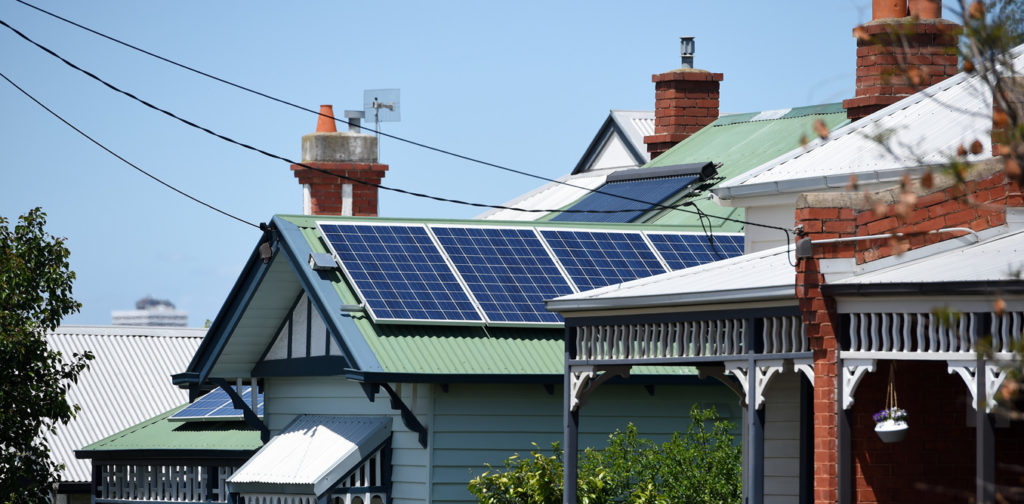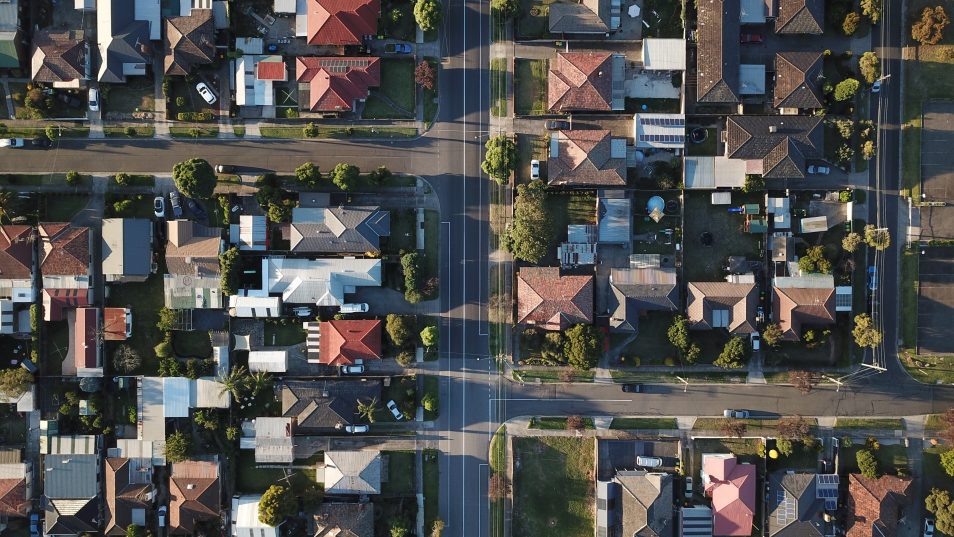
Some states are poised for a 500% growth in rooftop solar panels by 2030. AAP Image/Tracy Nearmy
Solar panels on houses in Melbourne. (AAP Image/Tracey Nearmy)
Home, sweet, eco-friendly home.
The residential sector significantly contributes to Australia’s greenhouse gas emissions, and electricity bills remain high. But Australians are only slowly embracing sustainable and energy efficient housing.
We’ve been working with the team at Renovate or Rebuild to help Australian homeowners choose between rebuilding or renovating while on their quest for healthier, comfier and energy efficient living spaces.
Build me up (Buttercup)
Knocking down an older property and rebuilding a new one may deliver time, cost and design benefits. But what impact does it have on the environment?
When it comes down to what’s greener, renovating often beats rebuilding. However, exactly what’s done with the remodelled or rebuilt house makes an enormous difference.
We track the energy efficiency of new homes through the Australian Housing Data Portal. The good news? Homes are becoming more energy efficient across the country.

Renovate or Rebuild is created around the idea of a Positive Energy Home – a home that is healthy, efficient, comfortable, and that creates more energy than it consumes.
Make it fashion… but functional
According to the Department of the Environment and Energy, Australian households are directly responsible for almost 20% of Australia’s greenhouse gas emissions.
The first step in creating a healthy, efficient, and comfortable home is all about low-tech solutions – orientation, insulation, use of materials, shading, and where you place your windows.
Heating and cooling accounts for 40% of household energy use, making it the largest energy user in the average Australian home. However, very little energy is required to make a well-designed house comfortable, and mechanical heating and cooling shouldn’t used as a substitute for intentional design.
Efficient and well-designed lighting can make for significant energy savings. The first step is to design your home to maximise the use of daylight so that electric lighting is not required during daylight hours. Then, create a lighting strategy that meets your needs in the most efficient way.
Take a load off
Building a positive energy home is all about selecting the right energy efficient appliances, from your hot water system to fridges, freezers, dishwashers, and televisions.
Dispatchable energy generation and storage (like household solar with a battery) is becoming increasingly accessible to the average homeowner. By harnessing solar energy during the day and storing it, you can use your energy on your schedule and even export back to the grid.
While these systems can be expensive to install, rebates and other financial incentives may be available to offset the initial cost.
To get the most out of your renewable energy system, minimising energy demand in the home first is crucial. We’ve compiled a few tips for Summer and Winter, but here’s a reminder:
- Turn off and unplug appliances at the wall when you’re not using them.
- Dress for the temperature by putting on a jumper and warm socks instead of turning on the heater.
- Only use the washing machine and the dishwasher when they are full. Otherwise, adjust the water level to match a partial load.
Watch real Aussies tackle the question of whether to Renovate or Rebuild.


10th March 2020 at 7:52 am
Houes don’t exist in a vacuum: how we treat our outdoor space also matters. And in the cities and suburbs that means at least 20% green space to avoid the Urban Heat Island Effect.
We also need our cities and suburbs to provide refuge, habitat and food for animals from insects (like bees), birds and animals especially when their environments are being adversely affected by drought, fire and flood, as is becoming increasingly common with climate change. And it’s not just farm land that can be used to store more carbon: we can treat urban land in ways that store more carbon as well.
The house that is built to the maximum size allowed on the block also impacts on what their neighbours can grow.
As Australian houses are the largest on the world scale: so their is definitely scope to scale them down and still live well.
So in the conversation about renovate or rebuild it would be good to also consider doing so in a way that acknowledges the importance of green space, including doing the things that we need to do to support that green space, like capturing water, rain gardens etc.
4th July 2019 at 12:21 pm
While spending a month in Perth living in a house on a battle-axe block, I started wondering if the increasing heat in the summer there was partly due to the multitude of airconditioners running and pumping their hot air outside to the neighbours’ airspace. I wonder if there has been a study of this effect?
When designing our new home in Albany, we had some wonderfully effective hints from an eco-architect and from research into Nordic design. It is a glorious result, warm with the winter sun and cool with the cross-flow breeze in summer. House sitting in ill-designed houses gives you lots of ideas how not to!
28th June 2019 at 4:53 pm
I totally agree! We have just finished renovating our 1950s bathroom (that had a 1970s makeover) – a sight to behold.
I resisted all suggestions that we needed to knock out walls and make our 6’x9′ room bigger (it’s an old house, you have to think in feet!). Yes, it now looks modern, but you know what? We don’t need a bath standing in the middle of an enormous room. With a bit of creative thinking, we have a very chic new bathroom, slotted into an existing space… still with a separate bath and shower, and a vanity. Our one luxury is the heated towel rail, but as we run our house almost exclusively on solar power, we felt we could justify it. The towel rail has the added advantage of not only drying the towels, but adding warmth to the room. If we had listened to the “experts:, we would have knocked out walls, put in underfloor heating and spent a small fortune. We have very happily upcycled our bathroom (and the old cast iron bath has been donated to be reused as a water trough on the farm).
28th June 2019 at 3:43 pm
Your article is interesting and gives some great pointers. The crucial piece of information that is missing: What is the break-even point of the energy used by an old inefficient house, compared to the amount of energy required to build a new home including the energy required to create all of the building materials?
How much would that break-even point be extended by some of the basic improvements suggested in the article?
13th June 2019 at 2:08 pm
I recently renovated my bathroom. My house is a 1960s classic with it’s original kitchen that I love. I was given 5sqm of period square tiles in a lovely cream that goes with the overall house, and I found a secondhand pedestal basin online for 20 dollars. The tiles was not nearly enough to carry out my renovation objects but instead of following the advice of renovation teams, bathroom experts and relevant shops and starting again with all the design elements, I decided to stick to my guns and begin the design with the tiles and the basinas givens. The design was therefore very tricky, but I think because of this, and my love of design, I have ended up with a beautiful and funky bathroom that is period appropriate and yet very contemporary at the same time. Designing to limits, where you are forced to think outside the square, can lead to better and more ” felt” outcomes.